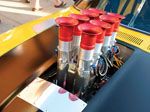
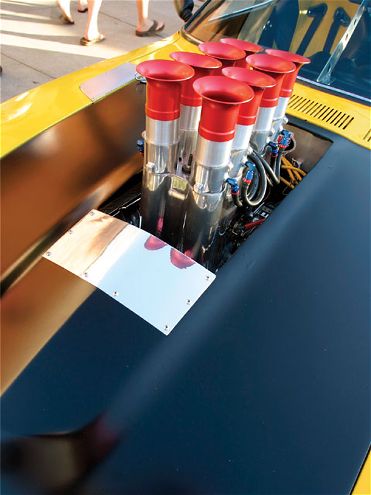 We saw this mechanical fuel-injection setup on a street-driven big-block Chevy at Cruisin' Grand, the Escondido, California, cruise, so there is hope for the brave souls who do want to run mechanical fuel injection. Anything is possible with enough tuning time.
We saw this mechanical fuel-injection setup on a street-driven big-block Chevy at Cruisin' Grand, the Escondido, California, cruise, so there is hope for the brave souls who do want to run mechanical fuel injection. Anything is possible with enough tuning time.
Mechanical Fuelie Mopar
Doug Rempel, Hebron, NE: I bought a complete Hilborn setup minus hoses and fittings that fit my Dodge 440. Everything I have read says it is not very street friendly. I am willing to tune it for driveability versus track time. I plan on getting the system flowed and set up for a baseline. Will the driveability really be that bad? What about performance versus a carb at the track?
Jeff Smith: We've had only limited personal experience with mechanical fuel-injection systems on a blower, Doug, and we've also heard the same kinds of things about these injection systems. We're going to assume you want to make this system work for a street-driven car rather than a drag-race-only combination. Basically, mechanical fuel-injection systems are designed to perform best in two areas: idle and wide-open throttle (WOT). The aspect you will find most challenging and what should be of most concern for a street-driven engine is part-throttle.
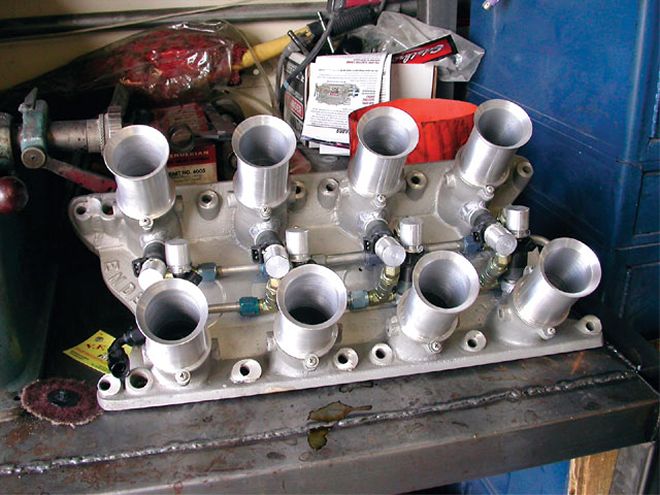 Converting a Hilborn mechanical fuel-injection manifold over to EFI is not really that difficult. You can even install the injector bungs without welding using epoxy. This is a small-block Ford manifold that our buddy Tim Moore is converting for his 289-powered GT-40 replicar.
Converting a Hilborn mechanical fuel-injection manifold over to EFI is not really that difficult. You can even install the injector bungs without welding using epoxy. This is a small-block Ford manifold that our buddy Tim Moore is converting for his 289-powered GT-40 replicar.
There are a couple of issues involved with tuning an individual runner manifold like a Hilborn. First, all the throttle plates must be set to flow the same amount of air. You can get close with a feeler gauge on the opening, but to truly set them properly, you need to measure the amount of air going through each stack. There used to be a little device called a uni-synch that can be found occasionally on eBay that measures the amount of airflow at idle for each stack, and all you do is set all the stacks the same.
Next, you need to establish fuel pressure. Most mechanical systems use a mechanical pump and tie in pump speed with fuel delivery. You can probably get help from Hilborn establishing your nozzle sizes for the injectors based on engine size and the amount of power you realistically are making. Nozzle diameters will also be affected by the amount of fuel pressure and the size and number of high-speed bleed orifices. The more pressure you run, the smaller the nozzles and the better the atomization, but this added pressure also reduces pump life.
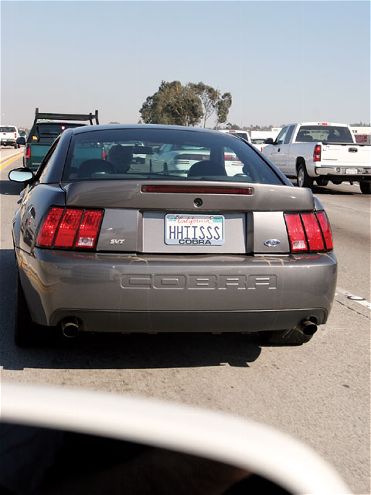 'CC Quickies
'CC Quickies
After all that, the real tuning begins with the barrel valve. This valve sets the amount of fuel that is returned to the tank with the remainder delivered at idle to the nozzles. This valve is adjustable, but you can't go too lean or the engine will probably stumble in transition to part- or full-throttle. Generally, the package will have to be set very rich to accommodate the dizzying number of variable-load characteristics present at part-throttle. The shape of the barrel valve will determine the amount of fuel delivered to the engine at part-throttle. It is possible to dial in the shape of that barrel valve to fit the requirements of your engine, but be prepared to spend lots of hours getting there. One way to really expedite this tuning process is to use an air/fuel ratio meter like the one from Innovate. It offers a data-logging feature that is invaluable in setting up your air/fuel ratio tuning parameters based on rpm and load.
'Cc Quickies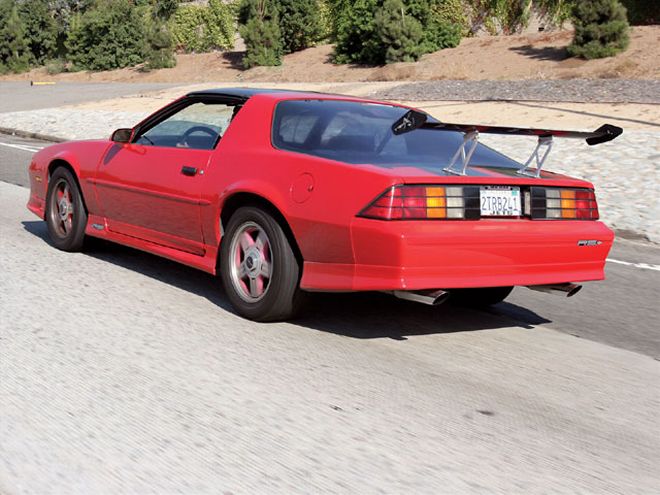 <strong>'Cc Quickies</strong><br>Wrong Wing: At least he's a Jets fan.
<strong>'Cc Quickies</strong><br>Wrong Wing: At least he's a Jets fan.
If all this sounds like a ton of work and time, it's only because it is. It will also be very frustrating if you try to do it yourself. We ran across a book on tuning mechanical fuel-injection systems for drag racing written by Bob Szabo that might be of use. We'd also highly recommend becoming fast friends with any drag racers or circle-track racers in your area who have experience with the Hilborn system. They can steer you in the right direction and save you untold amounts of grief. But even they probably won't be able to help with the part-throttle stuff because they rarely deal with that area of the fuel curve. Who knows, you might even be able to make this work well enough that driving the car would be fun.
If you really want the look of a Hilborn unit on the street without the constant tuning headaches and the pig-rich part-throttle air/fuel ratios, might we suggest converting the unit over to electronic fuel injection. The guys at Blower Drive Service (BDS) have a lot of experience converting these manifolds over to EFI, and it's not as complex as you might think. With EFI, you have total control over very finite points of the fuel curve and can dial in the idle, part-throttle, and WOT areas to make this a very streetable manifold. Craig Railsback of BDS tells us these EFI-converted manifolds offer unbelievably crisp throttle response once they are tuned properly. The initial cost for a complete EFI system from ACCEL, FAST, or BigStuff3 would be higher, but ultimately, the system will be far more enjoyable. You might even consider that budget EFI system from MegaSquirt.
'Cc Quickies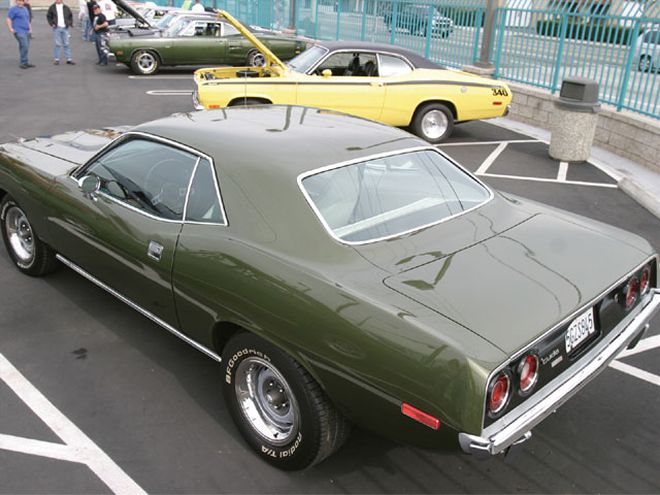 <strong>'Cc Quickies</strong><br>Chrysler by the Letters<br>A-Body: '60-'76 Dart, Duster, Barracuda<br>B-Body: '62-'79 Belvedere, Charger, Road Runner <br>C- Body: '65-'78 Newport, Polara, Fury<br>D-Body: Imperial, but it depends on when and whom you ask<br>E-Body: '70-'74 Barracuda, Challenger<br>F-Body: '76-'80 Volar, Aspen
<strong>'Cc Quickies</strong><br>Chrysler by the Letters<br>A-Body: '60-'76 Dart, Duster, Barracuda<br>B-Body: '62-'79 Belvedere, Charger, Road Runner <br>C- Body: '65-'78 Newport, Polara, Fury<br>D-Body: Imperial, but it depends on when and whom you ask<br>E-Body: '70-'74 Barracuda, Challenger<br>F-Body: '76-'80 Volar, Aspen
Your example of using a slightly larger tire going from a 215 to a 235 on the same size wheel also made those front tires wider by 20 mm (roughly 31/44 inch). This additional tread contact area to the road is what improved your braking efficiency, overcoming the slight difference in height between those two tires. You are correct that a taller wheel-and-tire combination will rotate slower. But because it is taller and (we'll assume) heavier, it now creates much more centripetal force. This adds to the load the brakes must overcome to stop the vehicle. Remember that the brakes are attempting to overcome the vehicle weight and speed as well as the combination of the weight and speed of the tires and wheels. I think you would agree that a heavier car and/or heavier tires and wheels are more difficult to stop than lighter versions. All those big SUVs running around with 24-inch-tall wheels and tires or those monster off-road pickups with 38-inch-tall mud tires have a tough time getting stopped in OE-equivalent braking distances because their tires and wheels are much taller and heavier. You can't argue with basic physics-not that we don't try!
As for your question about mechanical fuel-injection performance versus a carburetor, the answer lies in manifold design rather than in the way the fuel is introduced into the engine. A tunnel ram may come closest to duplicating the runner length of an individual ram manifold like the Hilborn. We'd estimate those power levels to be similar with a slight advantage going to the Hilborn setup if properly tuned. The advantage of a single carburetor is that it is immensely easier to tune, remains in tune longer, and offers relatively trouble-free street operation.
Too Hot
Gary V., Blaine, MN: I've got a 260hp stock replacement 350ci Chevy crate motor that I bought in 1999. The bottom end has been rebuilt, the crank was ground, I added new H-beam rods, 10:1 hypereutectic pistons, and the rotating assembly has been balanced. I installed a set of Vortec cylinder heads that have been ported with 0.600-inch-lift springs, guideplates, bigger valves, new guides, pushrods, and I am using Crane Energizer roller rockers. Here is my problem. The stock valve covers were too short, and the rockers just barely touch the valve covers, making a ticking noise. I then bought billet-aluminum center-bolt valve covers, and the bosses for the center bolts will not allow them to clear the valvetrain. Could you suggest a steel, tall, center-bolt valve cover?
Also, I've noticed the temp on this combo is very warm: 232 degrees. I have tried new T-stats, both 160- and 180-degree models, a new water pump (although not an aftermarket or electric), and a new aluminum radiator-one 14-inch electric fan pulling with a trans cooler on the outer side of the radiator and a 12-inch electric fan pushing from outside the radiator. I've tried stainless steel upper and lower hoses (advertised better heat dissipation), but it still runs warm. I didn't trust the 1989 gauge, so I have been using a laser-pointed heat gun and getting readings off the thermostat cover and upper hose of 232 to 235 degrees. I'm wondering if the port-and-polish job did anything. It was done by a local but reputable engine builder. Any other advice would be appreciated.
Jeff Smith: The difficulty you've run into, Gary, is the wider Crane Energizer rockers. The Crane Energizer rockers are an earlier design that used a larger aluminum body. These rockers worked well on the first-design small-block heads with a perimeter valve-cover bolt arrangement. But with the Vortec-style center-bolt valve covers, internal clearance becomes an issue. Crane has addressed this by building narrow-body Crane Gold Race rocker arms that are aptly named. These will clear the stock-type rocker-cover bolt stands, although we have run into very minor clearance problems even with these newer, narrow-body rockers. We've used these rockers on the stock valve covers without the rockers hitting the top of the covers, so this is one solution, although it's expensive.
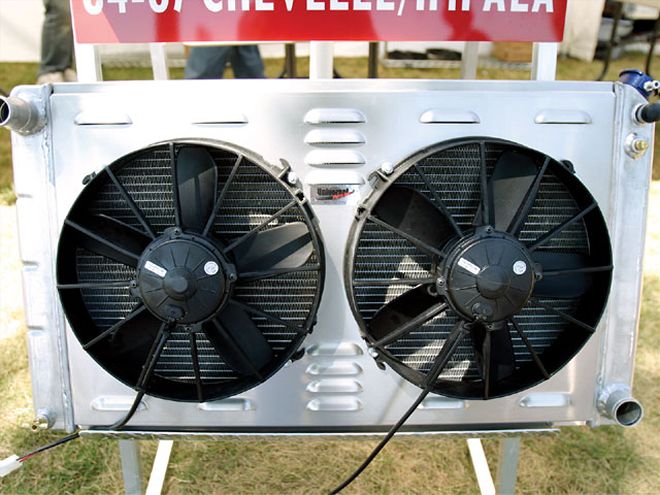 Electric fans work well, but for ultimate slow-speed cooling, a shroud assembly that will pull air from the entire radiator is the only way to go. Most shrouds also include small rubber flaps that will vent pressure at high speed to increase airflow at freeway speeds.
Electric fans work well, but for ultimate slow-speed cooling, a shroud assembly that will pull air from the entire radiator is the only way to go. Most shrouds also include small rubber flaps that will vent pressure at high speed to increase airflow at freeway speeds.
Another option is to try a taller aluminum valve cover. Trans-Dapt offers both short (PN 6992, $103.88) and tall cast-aluminum covers for the Vortec heads. The taller cover (PN 6986, $115.88 from summitracing.com) will clear the valvetrain but still might offer some interference with your wider rockers. We talked with the company's tech department, and it's possible to thin the cast-in stands slightly with a die grinder. But before you start grinding, measure the distance between the rockers where the stand sits and then measure the actual thickness of the stand. This should tell you whether you have enough material to work with. Remember, the stand is hollow, so you can only grind so far. Moroso also sells a center-bolt valve cover for these engines with a machined stand for extra rocker clearance. Perhaps if you called Moroso's tech department, someone could measure the thickness of the stand and you could compare that with what you need to clear your rockers. This is a die-cast rocker cover under PN 68030 ($146.88 at summitracing.com) that also includes eight stainless steel button-head fasteners and nylon washers. Moroso also offers fabricated aluminum valve covers PN 68025 ($349.95) that are cool, but obviously pricey.
As for your overheating problems, you don't mention when this happens. We'll assume the temperature rises during low-speed operation, that's where most cooling-system difficulties occur. Generally, this can be traced to a lack of water circulation due to an underdriven pulley ratio or to insufficient airflow. You mention that you have two electric fans on the radiator and a new aluminum radiator. While this sounds sufficient, you should consider using some kind of shroud in addition to the electric fans. For example, most of Flex-a-lite's electric fans now come with a built-in fan shroud. The shroud pulls air from the entire radiator rather than just the circumference of the fan. This can make a big difference in cooling-system efficiency, since perhaps as much as one-third of your radiator is not being used efficiently.
Another couple of things to try are not necessarily part of the cooling system. The first thing is to make sure the engine has sufficient ignition timing. Set the initial timing at around 10 to 12 degrees and then check the total advance curve. You can do this in the car with the dial-back timing light and a tach. The total timing (without vacuum advance) should be around 36 degrees, and it should be fully advanced by 2,600 rpm. More timing improves low-speed cooling by beginning combustion sooner. Another trick you might try is to add vacuum advance at idle with straight manifold vacuum. That can help. Also, pay close attention to air/fuel ratios. A very rich mixture can make an engine run hot. It sounds ironic, but leaning out the idle mixture can contribute to making the car run cooler.
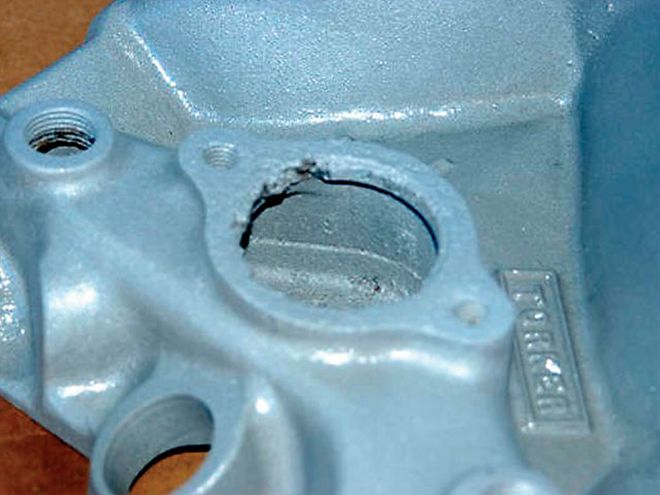 This photo of the oxidized thermostat housing on the intake manifold reveals just how damaging this electrolysis process can be on aluminum intake manifolds. This can occur with aluminum cylinder heads as well.
This photo of the oxidized thermostat housing on the intake manifold reveals just how damaging this electrolysis process can be on aluminum intake manifolds. This can occur with aluminum cylinder heads as well.
A Question Of A Corrosive Nature
Michael Breeding, via Car Craft e-mail: I'm working on a '60 Corvette doing semirestoration work for a friend of mine. I'm looking for a square-bore aluminum intake for a small-block Chevy that has an oil-fill tube hole in front. The existing Torker manifold has deteriorated around the thermostat hole. It showed up bad after bead-blasting and now it leaks. The only repair I can think of is to use a little JB Weld on the area. I've included a photo of the problem area.
Jeff Smith: This is a common problem with all engines. The corrosion is created by electrolysis, which is basically a chemical decomposition process. Let's get to the fix first, then we can talk about why this occurs and how to prevent it from destroying your choice aluminum intake manifold and heads.
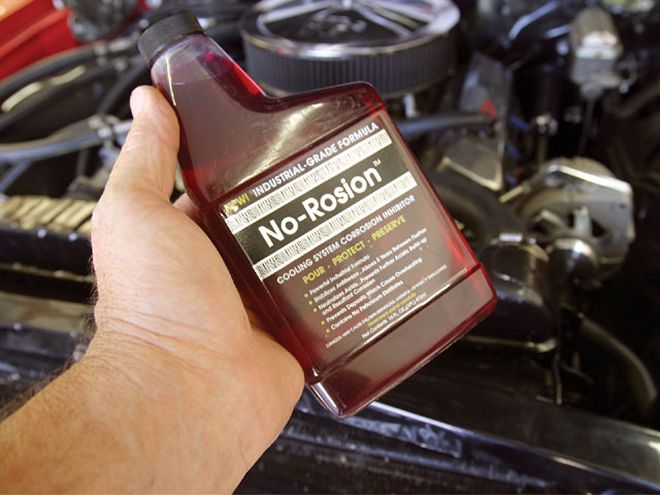 No-Rosion contains an additive that not only extends the life of antifreeze but also greatly reduces the risk of corrosion of soft metals, like aluminum, due to electrolysis.
No-Rosion contains an additive that not only extends the life of antifreeze but also greatly reduces the risk of corrosion of soft metals, like aluminum, due to electrolysis.
The quickest, least expensive fix is as you suggested, Michael. JB Weld is a two-part epoxy that can also be machined. The biggest hassle would be finding a shop that can cut a new shelf for the thermostat. Another, more permanent fix that is also more expensive is to have a competent welder repair the corroded area and then have a machine shop weld both a new shelf for the thermostat and the thermostat housing. It might also be possible to have the manifold repaired by a metal-spray process. This would be especially helpful for rare, OE manifolds where replacement manifolds in OE condition are impossibly expensive.
The cause of all this corrosion is also worth looking into as well as preventive measures you can take. Electrolysis is what causes much of the problem. This occurs in an area of the cooling system where you have two dissimilar metals (such as aluminum and steel from the thermostat) in close proximity submerged in an acid solution. This is also the formula for a lead/acid storage battery. If you remember something called the periodic chart of metals from chemistry class (OK, we didn't either, but trust us on this), as a grossly oversimplified explanation, the chart lists these metals from top to bottom based on how easily they corrode. Aluminum is right up there at the top with magnesium. These metals easily give up free electrons when subjected to the electrolysis process that occurs in a cooling system, especially in the area around the thermostat.
'Cc Quickies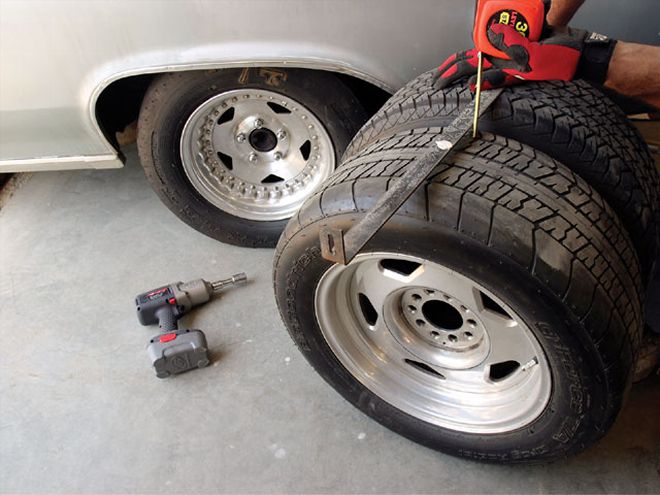 <strong>'Cc Quickies</strong><br>"R" Is for Rare<br>This is a one-of-107 '93 Cobra R Mustangs. It represents the first Mustang built by Ford's Special Vehicle Team (SVT). Note the 17-inch, black-painted wheels with bright, pony center caps. The cars lacked A/C, stereos, power locks, and power windows.
<strong>'Cc Quickies</strong><br>"R" Is for Rare<br>This is a one-of-107 '93 Cobra R Mustangs. It represents the first Mustang built by Ford's Special Vehicle Team (SVT). Note the 17-inch, black-painted wheels with bright, pony center caps. The cars lacked A/C, stereos, power locks, and power windows.
One way to fight this electrolysis process is to minimize the acid level in the cooling system. You can do this by not using antifreeze (which is acid-based), but that does not work well in winter conditions. Or, you can drain and flush the antifreeze every one to two years. Or, you can use a product that we've used for several years called No-Rosion from Applied Chemical Specialties, which is a pint bottle of chemicals intended to minimize the corrosive effects of electrolysis with an additive called molybdate. Using this additive can extend the drain intervals up to five years and also minimize corrosion in the cooling system for those who prefer to use straight water.
Another tip is to use distilled (NOT de-ionized) water when flushing the cooling system. Distilling water eliminates most of the solids from the water, which minimizes deposits that can form in the cooling system. It's also a good idea to add an overflow tank to your system that will collect any purged coolant from the radiator. Then, when the engine cools, the coolant is drawn back into the radiator, maximizing its efficiency. This also reduces the need to periodically open the radiator cap. Every time the cap is removed, additional air is introduced into the cooling system, adding oxygen that will enhance the corrosion process. This is one big reason why most new cars are equipped with overflow systems.
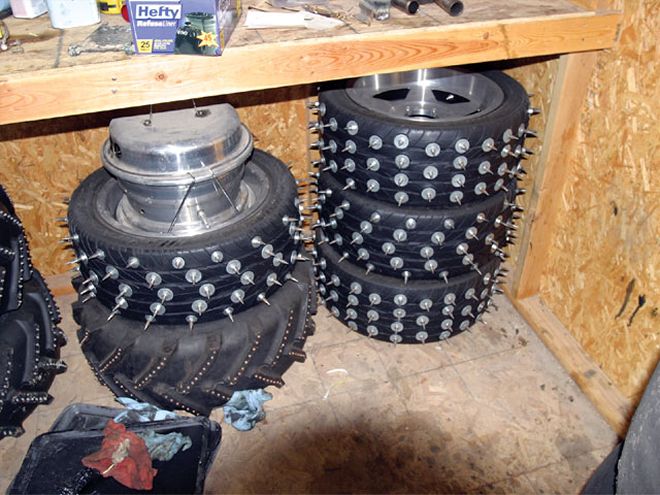 'Cc QuickiesYikes, spikes. During our El Camino road trip, we ran across Brian Pacheco's ice-racing tires for running on frozen lakes. During the summer, he plays around on his personal dirt-track oval in his backyard.
'Cc QuickiesYikes, spikes. During our El Camino road trip, we ran across Brian Pacheco's ice-racing tires for running on frozen lakes. During the summer, he plays around on his personal dirt-track oval in his backyard.
Gimme A Boost
Kris Shields, North Hills, CA: I'm looking for some information on octane boosters. With the price of race gasoline increasing by the day, I'm thinking that an octane booster might be a better way to pump up the octane rating of my regular pump gas. In California, the best gas we can get is 91-octane, while the rest of the country gets 93.
I read some information about a particular octane booster (there must be hundreds of them for sale now). The information I read was that one 12-ounce can of octane booster would pump the gas up by as much as eight points. Does that mean that this one little can would jump 91-octane gasoline up to the equivalent of 99-octane gas? That seems a bit too good to be true. So what's the deal?
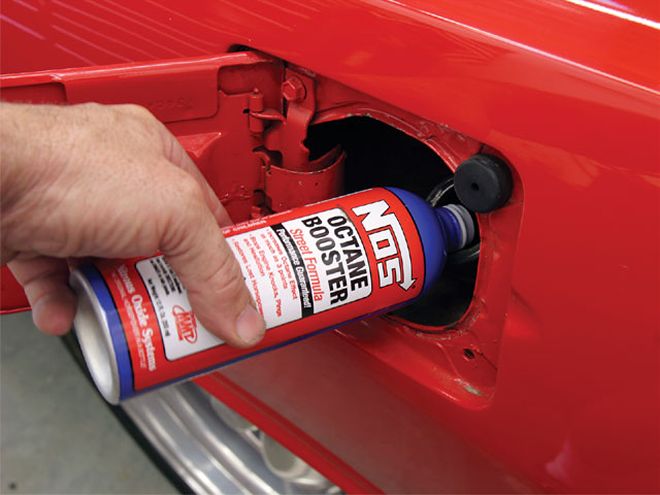 Octane boosters do increase the octane rating of pump gas, but only by very small amounts. For substantial increases in octane, mix a little race gas and have fun.
Octane boosters do increase the octane rating of pump gas, but only by very small amounts. For substantial increases in octane, mix a little race gas and have fun.
Jeff Smith: We went to the Fram/ Prestone/Autolite Web site and discovered that, yes, Prestone does offer an octane booster called 0 to 60. The company also explains that a "point" of octane boost is equivalent to one-tenth (0.1) of an octane number as listed on the gas pump. So, when a company refers to its octane booster raising the octane level by eight points, that actually means enhancing the pump-gas octane number from 91 to 91.8-big difference. Also keep in mind that octane boosters are not linear in their effect on octane numbers. In other words, adding two cans may increase the octane rating from 91 to 92.6, but after that, there are diminishing returns on how much octane will continue to rise.
The problem with most octane boosters is that for the price of the additive, you get very little return. A gain of two to five points is still moving the octane number an insignificant amount. This will cost anywhere from $5.95 to perhaps as much as $10 or more. A somewhat less expensive approach could be to mix unleaded race gas with pump gas. This is a much more straightforward proposition where mixing 5 gallons of 100-octane unleaded race gas with 5 gallons of premium pump gas rated at 93-octane would generate 10 gallons of gas with an overall octane number of 96.5. This is a gain of 3.5 octane numbers, something no octane booster we've ever seen can achieve. Granted, race gasoline is expensive. Let's say the price of a gallon of 100-octane race gas is $6, raising the octane level of 10 gallons of fuel to 96 octane would cost you $30. Again, this is not cheap.
'Cc Quickies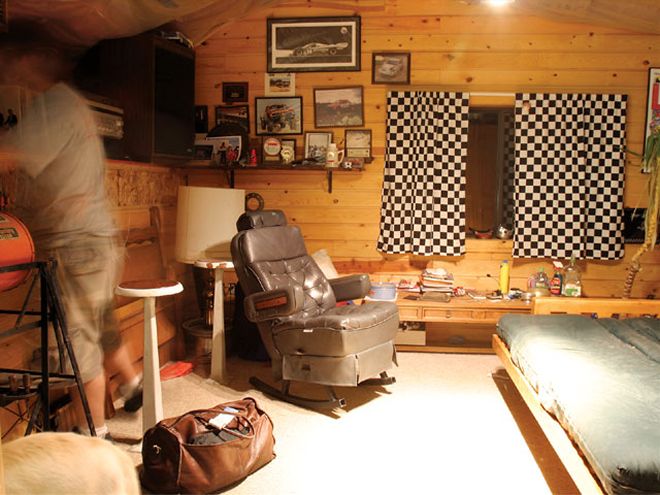 <strong>'Cc Quickies</strong><br>This is the upstairs room at Scott Gillman's Crested Butte shop he calls the Man Room. It's got a '30s-era headlight-aiming tool and other automobilia along with a killer stereo. Add a big-screen TV and a refrigerator and we'd never leave!
<strong>'Cc Quickies</strong><br>This is the upstairs room at Scott Gillman's Crested Butte shop he calls the Man Room. It's got a '30s-era headlight-aiming tool and other automobilia along with a killer stereo. Add a big-screen TV and a refrigerator and we'd never leave!
Another possible solution for those of you in the Midwest is E85, which is ethanol or alcohol fuel. E85 generally is rated at 105 octane, more octane than you really need. "Straight" alcohol has an R+M/2 number of 115 and then is mixed with 87-octane pump gas to come up with the 105 pump-gas-octane number. You could mix E85 in equal parts with 87-octane pump gas to lower the total octane count to roughly 96 octane, which would raise the 93-octane premium up to 96 octane. Mixing equal parts 105-octane E85 with 93-octane premium would generate roughly an octane rating of 99.
Keep in mind that mixing E85 with gasoline in equal parts will still mean you have to increase jet sizes. Mixed 50/50 with gasoline, this would still demand a larger overall metering area increase of 15 percent, which is roughly equivalent to five for a Holley carburetor on both the primary and secondary.
 A larger tire also increases the total footprint of the contact patch between the tire and the road. Ultimately, it is this contact patch area plus the load applied to the tire against the ground that affects stopping distance.
A larger tire also increases the total footprint of the contact patch between the tire and the road. Ultimately, it is this contact patch area plus the load applied to the tire against the ground that affects stopping distance.
A common misconception about octane is that a higher octane level also delivers more horsepower. This is just flat not true. Octane, by definition, is merely a rating of the fuel's resistance to detonation. The higher the octane rating, the more resistant the fuel is to detonation. Assuming your engine is tuned to its optimal total ignition timing number and the engine does not detonate, there is no performance increase to be gained by using a higher-octane-rated fuel. So, if your engine runs fine on 91-octane pump gas, there is no performance to be gained by using 93-octane gas. But if the engine likes additional timing (for a turbocharged or high-compression engine application, for example), then using a fuel with a higher octane rating will be a benefit. This allows the tuner to dial in more ignition lead without suffering the damaging effects of detonation.
Finally, we found several posts on the Internet asking questions about mixing your own octane-booster cocktail by using stuff like toluene and other industrial chemicals. We've even seen questions about mixing kerosene with gasoline. Unless you are well versed in the highly specialized petro-chemical world of blending gasoline, you'd best leave those mad-scientist experiments to the professionals. As for kerosene, with an absolutely hideous octane rating of something like 20, use it to wash parts-but that's all.
Tire Size And Braking
Steve Huffman, Guntersville, AL: In What's Your Problem? in the Oct. '06 issue you say that increasing tire diameter increases stopping distances. I think you need to take a look at that statement again. You are not taking into account the fact that the larger circumference slows down the wheel. The lever effect is inconsequential here. A 245/45R17 tire rotates 811 revolutions per mile. A 275/45R22 tire rotates 657 revolutions per mile, a much slower speed. It's the same as if the vehicle were doing 45 mph with the larger tire versus doing 65 mph with the smaller tire. It's physically impossible for braking to be decreased. I have found that going from a 215 to a 235 on the same size wheel increased my stopping ability on my pickup. Of course, none of this banter takes into account that the increased wheel and tire weight also affect stopping and launching negatively.
Jeff Smith: As with many things in life, Steve, there is a sliver of truth to your theory. Let's look into this a little closer. The facts are that the leverage effect and weight are the main reasons larger-diameter tires and wheels affect braking-system efficiency. Think of this as a situation where the tire and wheel are leveraging a given amount of torque against the brake caliper. A taller tire and/or wheel combination increases the length of that lever. So a given amount of brake pressure applied to the rotor must work against a greater force applied through the length of the radius, which is the distance from the axle centerline to the road surface. If we increase this distance with a taller tire, it gives the vehicle force (the combination of vehicle speed and its weight) more leverage to use against the brakes.